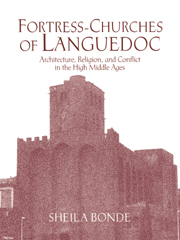Book contents
- Frontmatter
- Contents
- List of illustrations
- Acknowledgments
- Introduction
- 1 Ecclesiastical Fortification in the Middle Ages
- 2 The Larger Context: Languedoc in the Twelfth Century
- 3 The Buildings and the Documents: Maguelone, Agde, and Saint-Pons-de-Thomières
- 4 The Manning and Operation of Fortress-Churches
- 5 The Architectural Context: Sources and Parallels
- Conclusion
- Appendixes
- Tables
- Abbreviations
- Notes
- Bibliography
- Illustration credits
- Index
4 - The Manning and Operation of Fortress-Churches
Published online by Cambridge University Press: 02 November 2009
- Frontmatter
- Contents
- List of illustrations
- Acknowledgments
- Introduction
- 1 Ecclesiastical Fortification in the Middle Ages
- 2 The Larger Context: Languedoc in the Twelfth Century
- 3 The Buildings and the Documents: Maguelone, Agde, and Saint-Pons-de-Thomières
- 4 The Manning and Operation of Fortress-Churches
- 5 The Architectural Context: Sources and Parallels
- Conclusion
- Appendixes
- Tables
- Abbreviations
- Notes
- Bibliography
- Illustration credits
- Index
Summary
The student of any fortified enclosure must keep two groups in careful perspective: those who are inside, and those who aspire to that coveted position. The “included” and “excluded” normally comprised competing groups of people, but valued possessions, livestock, and even supernatural protectors could form part of the medieval equation. Fortress-churches also participated in the competition between “inside” and “outside” groups. With the fortified abbeys of Maguelone, Agde, and Saint-Pons-de-Thomières, the “outsiders,” identified textually, were “Saracens,” pirates, brigands, and heretics. The principal “insider” was the bishop or abbot. The cathedral chapters of Maguelone and Agde and the monastic community of Saint-Pons were normally “inside” with the bishop. The relationship of the chapter to the bishop could, however, become strained. The cartulary for Maguelone preserves evidence of conflicts between the bishop and chapter, especially in the second half of the twelfth century. At Agde, the bishop and chapter were in direct conflict during much of the eleventh and twelfth centuries.
Disputes often arose from the designation of certain groups as “insiders.” In 1168, the provost of Maguelone brought a complaint to Jean de Montlaur, bishop of Maguelone. The provost alleged that the bishop's knights entered areas of the monastery that should remain closed to them and that they stole some of the abbey's table knives. At Saint-Pons, the arbitrated agreement between Abbot Raymond of Saint-Pons and the viscount Roger Trencavel stipulated that, in addition to the bishop and monks, only the abbey's serfs were permitted in the cloister (Appendix 32).
- Type
- Chapter
- Information
- Fortress-Churches of LanguedocArchitecture, Religion and Conflict in the High Middle Ages, pp. 110 - 127Publisher: Cambridge University PressPrint publication year: 1994



